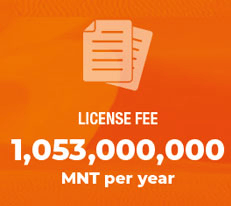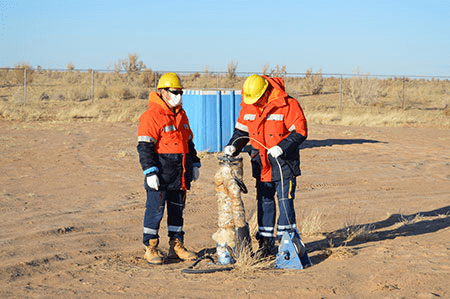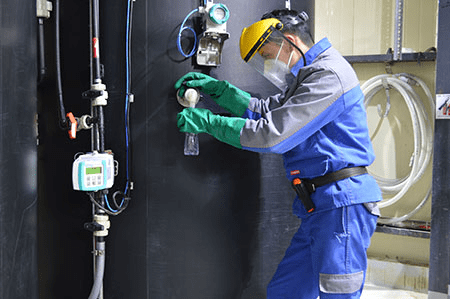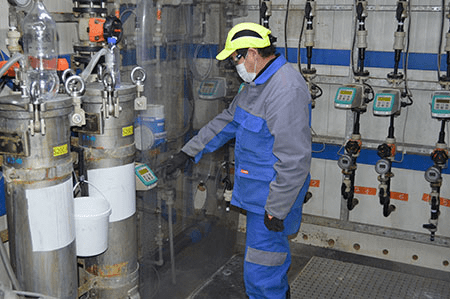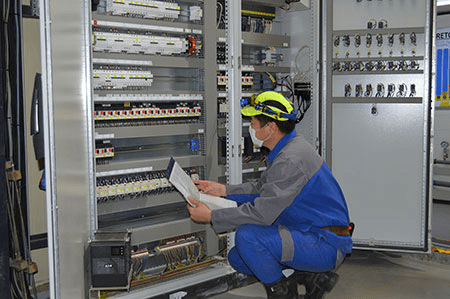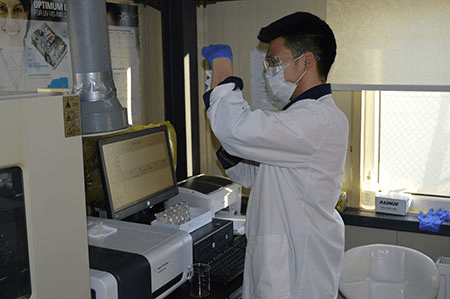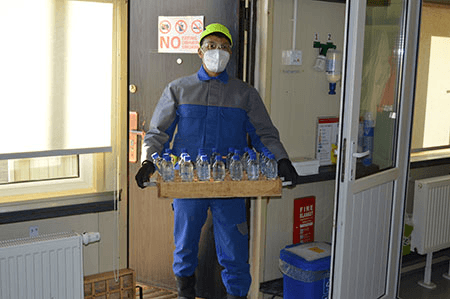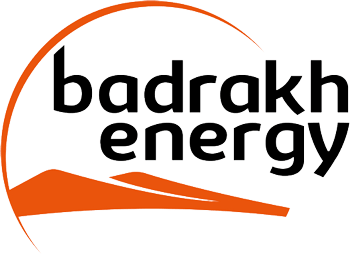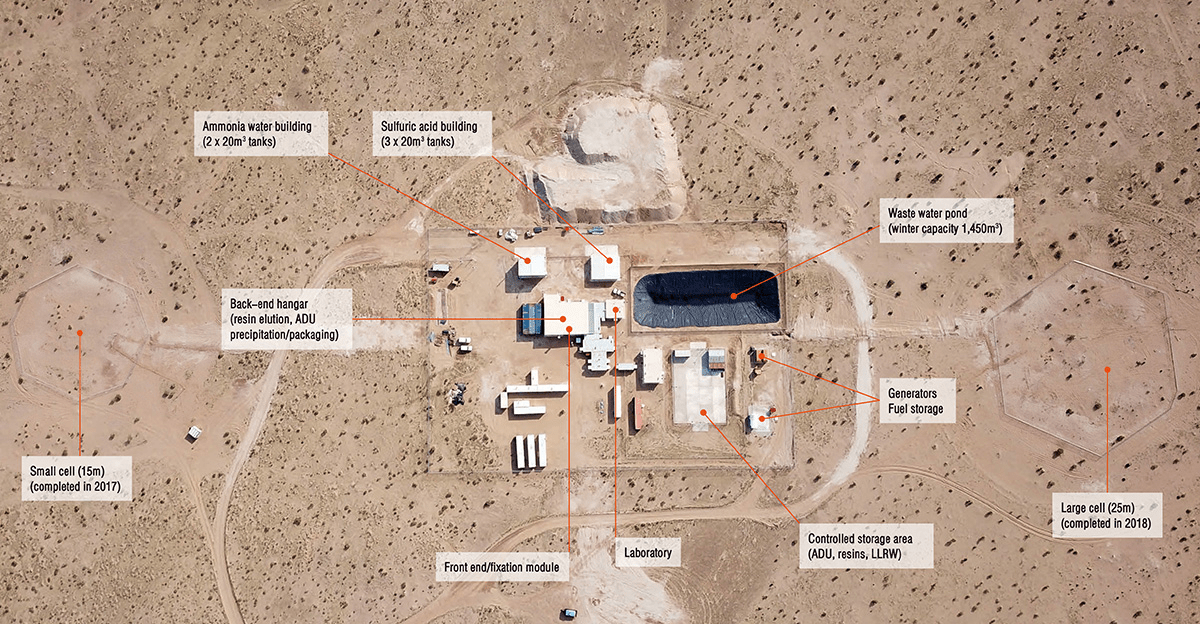Zuuvch ovoo project
Since 1996, COGEGOBI* has been continuously carrying out geological reconnaissance and exploration work in the Dornogobi and Sukhbaatar aimags, in southeastern Mongolia. These works have been conducted in accordance with the law on minerals adopted by the Mongolian parliament, and in compliance with the strictest safety, security and environmental standards.
Major achievements to date include the discovery of the Dulaan Uul deposit in 2002 and the world class Zuuvch Ovoo deposit in 2010, which significantly increased Mongolia’s overall uranium resources.
* COGEGOBI: Exploration subsidiary of Orano.
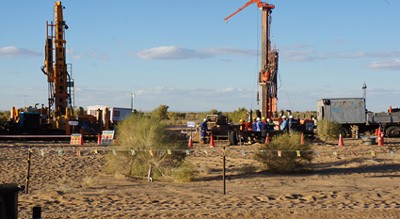
Drilling operation
FROM EXPLORATION TO MINING PROJECT DEVELOPMENT
1996-1997
Creation of COGEGOBI & preliminary geological reconnaissance in the Gobi desert
2002
Discovery of Dulaan Uul deposit
2006
May: Cooperation agreement with Mongolian Ministry of Industry and Trade
2009
October: Cooperation Agreement with Mongolia’s Nuclear Energy Agency
2011
June: Successful In Situ Recovery (ISR) test at Dulaan Uul site
August: Registration of Dulaan Uul resources, estimated at 6,260 metric tons
2013
February: Registration of Zuuvch Ovoo resources, estimated at 54,640 metric tons
September: Mitsubishi Corporation acquired 34% equity interest in AREVA Mongol
October: AREVA Mongol and MonAtom sign Shareholders’ Agreement for the governance of the Joint Venture, AREVA Mines
2015
February: Approval of Feasibility Study of Dulaan Uul and Zuuvch Ovoo uranium deposits, to be mined by ISR, and ore treatment in Ulaanbadrakh sum of Dornogobi province by Professional Council of the Mineral Resources of Mongolia
June: Granting of 3 mining licences for Dulaan Uul and Zuuvch Ovoo uranium deposits
2016
January: Registration of Dulaan resources, estimated at 4,750 metric tons
July: Granting of 3 mining licenses
2017
June: Mon-Atom takes a share in the capital of the Joint Venture
2018
January: AREVA Mines becomes Badrakh Energy
Pilot plant construction completed
Cooperation agreement signed with the Ulaanbadrakh sum and the Zuunbayan bagh
Evaluation of new opportunities for the project, if necessary, detailed engineering studies / Decision on the start of engineering and construction work for uranium processing plant
2019
Commissioning of the Zuuvch-Ovoo Pilot test facilities
2020
Increase of the proven reserves of the Zuuvch-Ovoo deposit to 93,291 tons of uranium
2021
Operations start of the 1st ISR cell of the Zuuvch Ovoo pilot
Zuuvch ovoo pilot test
The pilot test will extract uranium from the deposit using two cells. This uranium is then processed on site at the mini-processing facility, where it is separated from the solution, purified, dried and formed into the saleable product.
It is then packed as in a conventional processing plant and exported for further processing to the dedicated facilities.
The test started in July 2021 with the put in production of the first ISR Cell. It will last 200 and 300 days alternately on each cell and will cover all the stages of uranium mining, from extraction to production of an uranium concentrate containing 75% uranium.
After two years of pilot operations, approximately 20 tons of uranium will be produced. During the tests, analyses and monitoring will be carried out via 32 monitoring wells.
DULAAN UUL TEST (2010-2011)
COGEGOBI carried out an in-situ recovery technology test at the site of the Dulaan Uul between December 2010 and June 2011, with the authorization of the Mongolian Nuclear Energy Agency and the Mongolian Ministry of Environment and Green Development. This test concluded that uranium can be mined with the ISR method at the deposit and was an important stage in the transition from exploration to mining project development.
Supervision and environmental monitoring
During the tests performed at the Dulaan Uul site, monitoring wells were positioned at the upper and lower levels of the groundwater layer and inside and outside the uranium mining cells, in order to monitor the hydrodynamics and quality of the groundwater. The results showed that uranium could be recovered with very limited impact on the environment.
All the environmental impact results of the ISR test were sent to the relevant Mongolian administrative bodies, along with its post-test environmental impact assessment.
2-cell wellfield
2 208 m2 covered by wellfield
150-200 m
Drilling depth
10 m mineralization
32
controlling wells or piezometers
20tU
to be produced
The objectives of the pilot test
During the development phase, the technical, economic and environmental feasibility of a mining project is established. This involves confirming the resources identified by the geologists and characterizing the deposit and its ore.
A pilot installation is also set up during this phase to determine the mining and ore processing methods best suited to the deposit. The performance of on-site testing is part of the legal requirement in Mongolia to register the geological exploration reserves.
- The Pilot test results will provide information for the feasibility study and confirm technical and economic parameters.
- The test will provide data to confirm the expected low environmental impact of the ISR mining method chosen to operate the mine.
Controlling and monitoring
The test parameters will be regularly checked automatically by computer, which will also perform hydraulic and chemical analyses. Uranium, iron, acid concentration, pH, salinity and other characteristics will be analyzed daily on site in a laboratory set up specifically to monitor the process.
32 monitoring wells or piezometers are installed both around and inside the well field areas and above and below the deposit to measure the hydrodynamics and quality of the groundwater.
A systematic water sampling program is conducted before, during and after the test to assess any impact the process may have had on the environment and particularly on groundwater quality.
PROJECT BENEFITS
The Zuuvch Ovoo project brings local employment and skills development
96 %
of Badrakh energy' employees are from Mongolia
30 %
of Badrakh Energy' employees are locally hired
30
is the number of employees working on the pilot test
Economic Benefits from the Project
- The Badrakh Energy mining project is a large investment project for Mongolia.
- The project’s governance structure does not require recourse to sovereign financing.
- More than 1 bn USD in tax income over the life of the project at national and local level.
- Generation of significant purchase and business opportunities in Mongolia at national and local level.
- Participation in the development of local infrastructure.
- 1,000 + direct jobs once the mining starts, with the development of a highly skilled workforce & numerous training programs.

